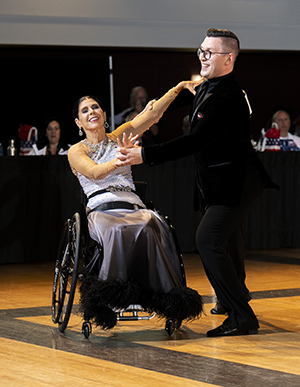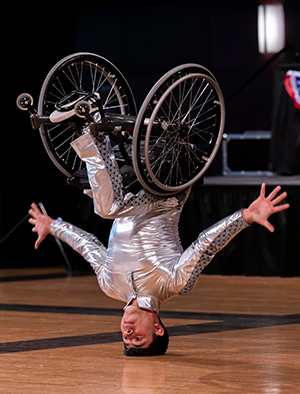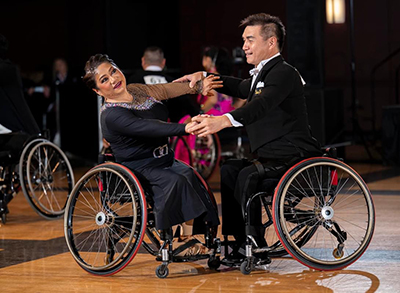By: Cheryl Angelelli
Gorgeous, bedazzled costumes shimmering under the bright lights, perfectly coiffed hair and makeup, hours of rehearsed choreography performed in perfect unison to heart-thumping music…welcome to the world of competitive wheelchair ballroom dancing.

I have been competing internationally in wheelchair ballroom dancing, known as Para Dance Sport, since 2017 with my standing partner, Tamerlan Gadirov. However, this past August 10-11, 2024, the competition felt a little different. That’s because it was the first sanctioned Para Dance Sport competition ever to be held in the United States. And not only was competing on American soil for the first time special, but the competition took place in my hometown of metro Detroit, so many of my friends and family were able to see me compete for the first time. The competition welcomed nearly 80 dancers from 15 countries, many visiting the United States for the first time.
Adding to the excitement and stress, I also helped organize the event along with the Reimagine Life Foundation (formerly the RIM Foundation) who hosted the event. Coordinating accessible hotel rooms, transportation, and meals for such a large group, plus raising funds and meeting with sponsors, took 18 months of planning. But I could not contain my pride rolling into the venue on the first day of competition and seeing everything we worked on come to fruition and the positive reactions of the teams who appreciated all the work and special details we put in place.
The United States was well-represented as well: Six couples competed in the sanctioned competition, four veterans and two new couples who made their Para Dance Sport debut. On the first day of competition, Tamerlan and I won a silver medal in International Standard and a bronze medal for our freestyle routine performed to Whitney Houston’s “I Will Always Love You” from the movie The Bodyguard. On day two, we placed fourth in Latin.
About Para Dance Sport
Wheelchair dancing originated in Sweden in 1968 for recreational and rehabilitation purposes. From there the sport’s popularity grew and in 1975 the first competition was organized in Sweden featuring 30 couples. Today, Para Dance is practiced in nearly 40 countries, with multiple competitions taking place every year in Europe and Asia.

Athletes are classified into either class 1 or 2 based on their impairment. Athletes competing in class 2 have fewer impairments than those competing in class 1. I am a C6 quadriplegic, and I compete in class 1. Dancers can also compete in Combi, Duo or Singles. I compete in Combi, which includes a dancer in a wheelchair competing with a standing partner. In Duos, both dancers use a wheelchair and in Singles, dancers compete solo. Para Dancers compete in International Standard which includes Waltz, Tango, Viennese Waltz, Foxtrot and Quickstep. In Latin, dancers compete in Samba, Cha Cha, Rhumba, Paso Doble and Jive. In freestyle events anything goes. Dancers perform hip-hop, lyrical, folk or other styles of dance.
Many of the dancers use a wheelchair specifically designed for dancing. The wheelchairs are lightweight, and the wheels are cambered (set on an angle), allowing the chair to turn and spin more quickly. Some dancers also have a third wheel in the back of their chair to prevent it from tipping backward. Para Dance is also open to manual and power wheelchair users.
A Whole New World
Competing internationally is nothing new for me. I spent 16 years competing as a Para Swimmer. I competed in the 2000, 2004, and 2008 Paralympic Games and won two silver and two bronze medals. When I retired from Para Swimming in 2024, I discovered Para Dance and quickly fell in love with the sport.
Para Dance is so different from Para Swimming. First, swimming is an individual sport and when I transitioned to dance, I had to learn to work with a partner. In addition, swimming was something I was naturally good at from a young age; dance really challenges me because it is not something that comes naturally to me. It is also a very expensive sport so I am only able to practice about 90 minutes a week. Dance allows me to express my creative side, but it is a subjective, judged sport, whereas in swimming a clock determines the outcome. And there is a whole lot that goes into packing and preparing for a wheelchair ballroom dance competition. There is pre-competition prep like manicures and spray tans. Then there is packing closed-toe shoes for Standard and open-toe shoes for Latin, plus makeup, jewelry, hairpieces and more. And let’s not forget costumes for every event, which can be pretty heavy to carry with all the rhinestones.
There is also my dance chair that I need to travel with in addition to my everyday chair. Oh, how I miss packing for a swim meet when all I needed was a bathing suit, cap and goggles.
Dance competition days usually start very early. Sometimes I am in hair and makeup as early as 5:00 a.m. because I have it professionally done. The competition itself can be 6-7 hours long or more. Therefore, I pack extra SpeediCath® Compact catheters, snacks to stay fueled and plenty of sports drinks to stay hydrated.

How to Get Started
When I started dancing, I experienced so much joy that I wanted to share it with others. So I co-founded Dance Mobility, a free wheelchair ballroom dance program for persons with disabilities funded by the Reimagine Life Foundation. It’s a beginner program, so whether you just want to dance for fun or you’re interested in competing, it’s a great place to start. My partner Tamerlan and I also travel around the country and bring the Dance Mobility’s introductory program to studios, rehab hospitals and students who are interested in learning about inclusive wheelchair ballroom dancing. Fred Astaire Dance Studios around the country have taken our Dance Mobility concept and created a curriculum for persons with disabilities to learn to dance, so that is another option to explore. To learn more about Para Dance visit dancemobility.org and follow @usaparadancesport on Facebook and Instagram.
Cheryl received compensation from Coloplast to provide this information, but reviews and opinions are her own. This information is for educational purposes only and should not be interpreted to contain treatment recommendations. Each person's situation is unique so your experience may not be the same. You should rely on the healthcare professional who knows your individual history for personal medical advice and diagnosis. Prior to use of SpeediCath or other product, refer to the product 'Instructions for Use' for intended use and relevant safety information.
SpeediCath® Compact catheters are prescribed for use by patients who require bladder drainage due to chronic urine retention or post void residual volume (PVR). Before use, carefully read all of the instructions. Call your doctor if you think you have a UTI or can't pass the catheter into the bladder. For more information regarding risks, potential complications and product support, call Coloplast Corp. at 1- 866-226-6362 and/or consult the company website at www.coloplast.us.